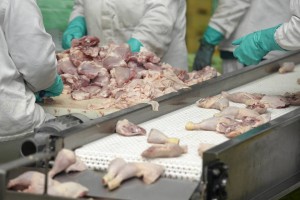Chicken has become a cheap staple meat but it’s not as cheap as you think and the difference in cost between low-cost factory chickens and high-welfare, organic chicken is less than you probably realise. Here’s why.
Various campaigns have increased awareness of animal welfare leading to better care legislation in recent years.
Unfortunately general food legislation hasn’t changed that much. Chicken has a reputation as a low-fat, healthy meat but much of the chicken sold in the developed world is no longer so low-fat or healthy.
You might think that chicken meat is something simple that they can’t mess about with but it’s just not so.
Fast Growing Breeds versus Traditional Broiler Chickens
Originally the only chicken that was eaten was unwanted cockerels and hens that had stopped laying. Old birds were made more appealing by slow cooking and tenderising – as in the classic Coq au Vin. This was a peasant dish in France and the acidity of the wine both tenderised and added flavour to the meat.
Nowadays commercial chickens are either layers or table birds. The cockerels from layers are disposed of as a waste product at 1 day of age. Instead of taking 18 to 24 weeks to grow to table size, modern fast growing breeds are at killing weight in just 8 weeks.
They pile on weight at a tremendous rate and, even in free range systems, they don’t move about much. Their legs don’t keep pace with their weight gain and often break. There short life is one of waddling between the food and water bowls.
The end result is a more profitable bird that has a higher fat content than slow-growing breeds. We’ve sacrificed quality of life for the bird and quality of the meat for ourselves in the pursuit of lower shelf prices.
Adding Value for the Producers to Factory Chickens Meat
Splitting the Chicken
By splitting the chicken into components, they increase the value. This is why you can buy breasts, legs, wings etc. separately It may be more convenient than jointing your own, but you pay for the privilege.
Factory Chickens – Added Water & Chemicals
The next step is to further increase the price by adding water. It is perfectly legal for the processor to add as much water as they want, i.e. as much as they think they can get away with, to your chicken. Often it’s just 15% of the weight but it has been known to be as high as 40%. So you end up paying meat prices for water.If they just injected water, then it would drain away so to hold it in the chicken they add polyphosphates which bind the water into the chicken.
Polyphosphates are approved for use as an additive in food and considered safe although a preliminary study published in the American Journal of Respiratory and Critical Care Medicine suggested they may be implicated in lung cancer. Average consumption of these chemicals has about doubled over the last ten years.
Whilst they’re at it, they add some salt and dextrose (a sugar) to the water. The reason for this is to ‘improve’ the flavour and disguise the wateriness of the product. Never mind that too much salt and sugar in the diet are bad for health, this is perfectly legal.
So we move from a healthy lean meat to a product that is high in fat, salt and sugar and might even increase your risk of lung cancer. If you buy some cheap chicken check the label, you may not normally bother checking the ingredients of chicken but you could have an unpleasant surprise.
Organic or Home Raised Table Chicken versus Standard Commercial Factory Chickens
Organic systems most often use slower developing breeds and home or very small svale producers dual-purpose breeds where the cockerels go for the pot and the hens to lay. So a superior, lower fat meat to start with. When looking at the cost of buying organic or the costs of raising your own table birds, this is something to factor in.
Secondly, if your cheap 1.5Kg chicken is actually 15% water, it’s really comparable to a 225gr smaller organic or home-reared bird. Yes you do pay more for quality and health, but not as much as you might think.
Related Articles
Keeping Chickens for Meat – Costs & Returns – The Economics
Related Frugal Food Articles
- Are Supermarkets the Best Place for Frugal Shopping?
- Beating the Supermarkets – End of Date Clearance Lines
- Beating the Supermarkets – 10 Money Saving Frugal Shopping Tips
- Beating the Supermarkets – Buying at the Best Price
- Best Before, Use By, Sell By, Display Until -What They Mean
- Get Healthy Food on the Table 7 Days a Week
- How The Food Industry Fools You – Factory Chickens
- How to Drink Quality Wine Without Breaking the Bank
- Reduce Food Waste & Save Money
- Top Reasons Why Fermented Food Is Good For Your Health




